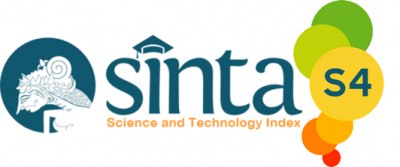- » Focus and Scope
- » Section Policies
- » Peer Review Process
- » Publication Frequency
- » Publication Ethic
Focus and Scope
SCAN - Jurnal Teknologi Informasi dan Komunikasi adalah jurnal nasional yang menyediakan sumber informasi ilmiah bagi para peneliti dan akademisi. Kami menerbitkan artikel penelitian murni, artikel review, dan studi kasus yang berfokus pada kecerdasan komputasional, jaringan komputer dan multimedia, rekayasa perangkat lunak serta topik lainnya yang terkait bidang ilmu komputer atau teknologi informasi.
Lingkup Jurnal SCAN meliputi, namun tidak terbatas pada:
- • Kecerdasan Komputasional dan Soft Computing
- • Pemrosesan Sinyal dan Citra Digital
- • Jaringan Komputer dan Multimedia
- • Rekayasa Perangkat Lunak
- • Optimasi dan Sistem Pengambilan Keputusan
- • Web & mobile Intelligence
- • Big Data
- • Komputer Grafis
- • Komputasi Paralel dan Terdistribusi
- • Algoritma dan Pemrograman Komputer
- • Komputasi Numerik
- • Pervasive Computing
- • IT Service Management
Section Policies
Articles
Peer Review Process
Tipe review : Single Blind
Lama review:
Poin-poin yang dinilai:
Pengambilan keputusan: (siapa yg memutuskan accepted)
Jumlah reviewer per artikel:
Publication Frequency
SCAN - JURNAL TEKNOLOGI INFORMASI DAN KOMUNIKASI
Open Access Policy
This journal provides immediate open access to its content on the principle that making research freely available to the public supports a greater global exchange of knowledge.
Publication Ethic
Section A: Publication and authorship
• All submitted papers are subject to strict peer-review process by at least two international reviewers that are experts in the area of the particular paper.
• Review process are blind peer review.
• The factors that are taken into account in review are relevance, soundness, significance, originality, readability and language.
• The possible decisions include acceptance, acceptance with revisions, or rejection.
• If authors are encouraged to revise and resubmit a submission, there is no guarantee that the revised submission will be accepted.
• Rejected articles will not be re-reviewed.
• The paper acceptance is constrained by such legal requirements as shall then be in force regarding libel, copyright infringement and plagiarism.
• No research can be included in more than one publication.
Section B: Authors’ responsibilities
• Authors must certify that their manuscripts are their original work.
• Authors must certify that the manuscript has not previously been published elsewhere.
• Authors must certify that the manuscript is not currently being considered for publication elsewhere.
• Authors must participate in the peer review process.
• Authors are obliged to provide retractions or corrections of mistakes.
• All Authors mentioned in the paper must have significantly contributed to the research.
• Authors must state that all data in the paper are real and authentic.
• Authors must notify the Editors of any conflicts of interest.
• Authors must identify all sources used in the creation of their manuscript.
• Authors must report any errors they discover in their published paper to the Editors.
Section C: Reviewers’ responsibilities
• Reviewers should keep all information regarding papers confidential and treat them as privileged information.
• Reviews should be conducted objectively, with no personal criticism of the author
• Reviewers should express their views clearly with supporting arguments
• Reviewers should identify relevant published work that has not been cited by the authors.
• Reviewers should also call to the Editor in Chief’s attention any substantial similarity or overlap between the manuscript under consideration and any other published paper of which they have personal knowledge.
• Reviewers should not review manuscripts in which they have conflicts of interest resulting from competitive, collaborative, or other relationships or connections with any of the authors, companies, or institutions connected to the papers.
Section D: Editors’ responsibilities
• Editors have complete responsibility and authority to reject/accept an article.
• Editors are responsible for the contents and overall quality of the publication.
• Editors should always consider the needs of the authors and the readers when attempting to improve the publication.
• Editors should guarantee the quality of the papers and the integrity of the academic record.
• Editors should publish errata pages or make corrections when needed.
• Editors should have a clear picture of a research’s funding sources.
• Editors should base their decisions solely one the papers’ importance, originality, clarity and relevance to publication’s scope.
• Editors should not reverse their decisions nor overturn the ones of previous editors without serious reason.
• Editors should preserve the anonymity of reviewers.
• Editors should ensure that all research material they publish conforms to internationally accepted ethical guidelines.
• Editors should only accept a paper when reasonably certain.
• Editors should act if they suspect misconduct, whether a paper is published or unpublished, and make all reasonable attempts to persist in obtaining a resolution to the problem.
• Editors should not reject papers based on suspicions, they should have proof of misconduct.
• Editors should not allow any conflicts of interest between staff, authors, reviewers and board members.









